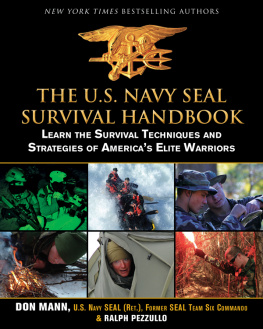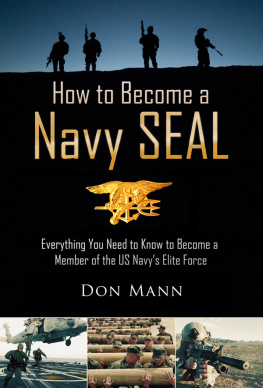


Copyright 2020 by Don Mann and Kraig Becker
All Rights Reserved. No part of this book may be reproduced in any manner without the express written consent of the publisher, except in the case of brief excerpts in critical reviews or articles. All inquiries should be addressed to Skyhorse Publishing, 307 West 36th Street, 11th Floor, New York, NY 10018.
Skyhorse Publishing books may be purchased in bulk at special discounts for sales promotion, corporate gifts, fund-raising, or educational purposes. Special editions can also be created to specifications. For details, contact the Special Sales Department, Skyhorse Publishing, 307 West 36th Street, 11th Floor, New York, NY 10018 or .
Skyhorse and Skyhorse Publishing are registered trademarks of Skyhorse Publishing, Inc., a Delaware corporation.
Visit our website at www.skyhorsepublishing.com.
10 9 8 7 6 5 4 3 2 1
Library of Congress Cataloging-in-Publication Data is available on file.
Cover design by Brian Peterson
Print ISBN: 978-1-5107-5204-7
Ebook ISBN: 978-1-5107-4578-0
Printed in China
CONTENTS
PART I
DRAWING A LINE IN THE SAND
O n August 2, 1990, Iraqi forces, under orders from Saddam Hussein, invaded the neighboring country of Kuwait. The dictators goal was to seize Kuwaiti oil fields and quickly take control of the countrys petroleum production facilities. By disrupting output from those refineries Hussein could force the price of oil to increase sharply on the international markets, lining his pockets with the profits as a result.
Woefully outnumbered, outgunned, and outmatched, the Kuwaiti forces were soundly defeated in just two days. Iraqs Republican Guard ruthlessly smashed all resistance, wiping the opposition from the battlefield. Some Kuwaiti units fled into nearby Saudi Arabia and Bahrain to escape destruction or capture, but most were eliminated within hours of the start of the invasion.
Iraqs aggressive attack on its neighbor was quickly and resoundingly condemned by the international community. Within days, the United Nations approved economic sanctions against the Middle Eastern country, and a naval blockade was soon put in place to keep vital supplies from reaching Iraqi shores. But Hussein remained unfazed and settled in for what looked like a protracted conflict. He argued that Kuwait was historically a part of Iraq anyway and that he was only reclaiming what was rightfully his.
A weeks-long standoff ensued, during which Iraqi forces dug in and hardened their positions in Kuwait. Meanwhile, an international coalitionled by the United Statesbegan to build up its presence in the region. As the months passed, more than 900,000 troops were sent to Saudi Arabia and other nearby countries in anticipation of an armed clash. For the US, it was the largest deployment of its armed forces since the Vietnam War, with the Navy sending two full battle groups into the Persian Gulf. Meanwhile, the US Air Force dispatched fighter planes and bombers to help patrol the skies, and the Army prepared for a deadly showdown with Iraqs well-trained and well-equipped forces.
Tensions ran high on both sides, with negotiations, eventually breaking down altogether. Hussein refused to withdraw his troops from Kuwait, while the growing allied coalition would accept no other course of action. On November 29, the United Nations passed a resolution authorizing the use of military force if Iraq did not exit Kuwait by January 15, 1991. In a sense, the resolution put Saddam and his forces on the clock, giving them a hard deadline for when to relinquish control over the captured territory.
Eventually that deadline came and went and, as promised, the US and its allies launched Operation Desert Storm. The plan was to conduct a systematic and controlled air campaign against the Iraqi army, eliminating its ability to maintain a high level of defense. For five weeks allied aircraft bombarded strategic locations across Kuwait, destroying Iraqi equipment, personnel, and moral. The bombing raids were conducted day and night, often with precision accuracy and devastating results.
The air campaign served as the precursor to Operation Desert Saber, which, on February 24, saw allied ground forces invade Kuwait with the goal of expelling the Iraqis. After weeks of intense attacks from the sky, Saddams militaryincluding the elite Republican Guardwere severely weakened and soon beat a hasty retreat. In their wake they left death and destruction, setting fire to hundreds of Kuwaiti oil fields and destroying crucial infrastructure as they went.
The ground portion of the Gulf War was over in a manner of just a few days. Within 100 hours of the start of Operation Desert Saber, the Iraqi army had either been destroyed or had retreated across the border. Thousands of enemy soldiers were captured or killed, with Iraqi tanks, armored cars, aircraft, and other vehicles littering the battlefield.
Saddam Hussein suffered a resounding defeat with his troops being expelled just as quickly as they had captured Kuwait only seven months earlier. It was an impressive display of US military might, although the allied forces played an important part in helping to liberate the captured nation.
As you can probably imagine, US Navy SEALs had a crucial role during the Gulf War. In fact, long before the allies began building up their forces, SEALs were already on the scene and conducting important operations. Within days of the Iraqi invasion, President George H. W. Bush ordered the start of Operation Desert Shield, which set in motion plans to escalate a military build-up in the region. It would take months for those plans to fully come together, but in the meantime the SEALs were already scouting the area, conducting sabotage missions and boarding incoming ships to inspect for contraband.
Early on the SEALs also served as instructors and advisors. As some of the first US personnel on the ground in Saudi Arabia, SEAL team members showed the Saudi military how to effectively call in air strikes and bombing raids in preparation for their defense. Those lessons would prove invaluable once the Gulf War officially got underway, assisting pilots in locating and eliminating important enemy targets.
Once Operation Desert Storm began on January 17, the SEALs turned their focus to other matters. One of their most important jobs was to identify and map the location of Iraqi mines that had been deployed along the Kuwaiti coast to help fend off an amphibious assault. They would also conduct nightly recon missions to not only assess enemy strength and readiness but to observe the impact that the air war was having on Saddams forces.
Those missions typically began 500 meters from shore, where the SEALs would silently slip into the water and swim toward the beach. Water temperatures typically hovered around 50F and the surface of the Persian Gulf had a layer of oil on it at all times, making the missions far from comfortable or easy. Still, the SEALs provided critical intelligence that would later assist allied forces when they launched the ground assault in February.

The battles that count arent the ones for gold medals. The struggles within yourself, the invisible, inevitable battles inside all of us, thats where its at.
Next page
















